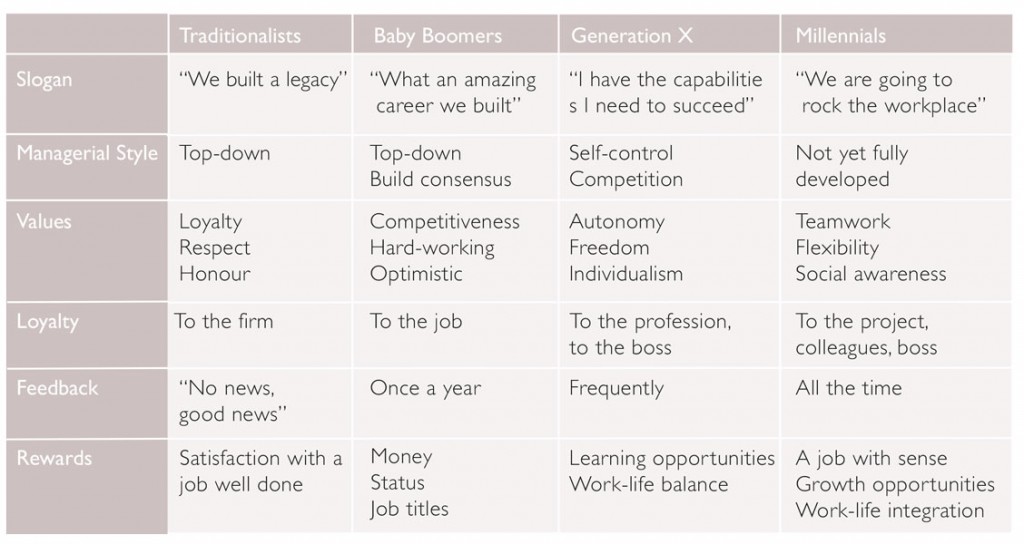By Andrés Hatum
The global ageing population and the new generation of young professionals entering the market are changing the shape of the workplace. Companies need to look forward and prepare for the workforce of the future and understand the organizational changes this will bring.
While new ways of organizing will be increasingly important for firms to succeed in the future, it will also be important to take into account the deep demographic changes occurring in the workplace. Indeed, firms are already facing the challenge of transforming their structures and ways of organizing to incorporate the new generation.
Never before have organizations seen three and even four generations working together. These overlapping generations have great implications; not only for the way work is performed, but also for the way firms need to think about their future talent management strategies and the HR practices required to support their human capital. Heterogeneity and diversity have replaced the homogeneous workforce that pervaded before.
The generations working together today that are relevant for the purpose of our study are: Baby Boomers, Generation X, and Generation Y, or the so-called Millennials. Baby Boomers refers to the post-war generation, born between 1946 and 1964; Generation X (Gen X) refers to individuals born between 1965 and 1980; and Generation Y (Gen Y) refers to persons born between 1981 and 1997. Although no longer in the workplace, I refer also to the Traditionalists, born between 1922 and 1945.
[ms-protect-content id=”9932″]The number of US workers over the age of 40 has increased significantly. By 2010, 51% of the US workforce was 40 years of age or older, while Millennials represented only 22% of the workforce. However, by 2014 Millennials are expected to make up almost 47% of the US workforce. These figures suggest that an impressive replacement of the workforce will occur over a relatively short period of time, and thus underscore the emphasis companies will have to place on adapting to the fast-changing demographics.
Traditionalists served their countries during the Second World War. But they also witnessed the First World War and participated in the Korean War. Loyalty, respect and honour define the values of the traditionalists. Many of them have military experience and as a result, the managerial style of this generation tends to follow a top-down approach to getting things done. Not surprisingly, traditionalists embrace the idea of working with large institutions, as they view such institutions as the source of a stable career that one can be proud of.
Baby Boomers are still a large workforce. However, as of 2014, Baby Boomers are between their early fifties and retirement age. The fact that a large proportion of the current workforce is near retirement is a huge challenge for firms that need to build a bridge between generations to prepare for their continued success in the future.
Baby Boomers witnessed the Cold War, the Vietnam War, Watergate, the first time a man walked on the moon, as well as the civil rights struggle and the assassination of President Kennedy. Moreover, they were able to watch each of these events on TV. Indeed, one could say this generation was raised with the TV. Power was being shared by two generations, Baby Boomers and Traditionalists. Boomers were raised under a top-down managerial approach, but needed to learn how to build consensus. This is an optimistic generation that has been able to live in a wealthy, prosperous world.
After the Baby Boom generation, babies went bust, with the birth rate declining dramatically. This new smaller generation, Gen X, accounts for managers in their mid-30s through mid-40s. This generation has witnessed great technological developments and is technologically savvy, though Gen Xers are digital immigrants. The toppling of the Berlin wall, the AIDS epidemic, the drugs crisis, and the Persian Gulf War were among the most important events this generation witnessed in its formative years. The sceptical Gen Xer has seen many parents divorce, corporate scandals, corruption, and well-established institutions be called into question.
While Boomers’ lives were impacted largely by the TV, many inventions have changed Gen Xers’ ways of working: cable TV, fax machines, video games, Palm Pilots, pagers, mobile phones and personal computers, among others. Not surprisingly, Gen X has clashed with the other generations still in the workplace. The managerial style of the three generations can be described as “chain of command” (Traditionalists), “change of command” (Baby Boomers), and “self-command” (Gen X). Given these different management styles, such clashes have been in a sense predictable.
The Millennial Generation: “We are going to rock the workplace”
Many articles and books have attempted to describe Millennials – also referred to as Generation Y (Gen Y), Generation.com (due to their natural ability for handling technology), and Generation Next, among others – in an effort to understand their behaviour as well as how this new generation fits in the workplace.
Millennials have been variously depicted as self-absorbed, distrustful, disloyal, unconcerned with rules and superficial, among other not particularly flattering adjectives. However, these pessimistic descriptors do not help firms understand how to work with and support these new entrants to the workforce that in America alone [Millennials] will account for 58 million people by 2014.
Realistic is the best adjective to describe this new workforce. Consider for a moment where Millennials are coming from: for the most part, they are children of Baby Boomers who dedicated their lives to companies and ended up having to jump from job to job over the course of their lives and careers. The economic conditions and crises affecting the Boomer generation required that they shift jobs and careers. As a result, the Millennial generation did not grow up in an era of increased job security as their parents had, but instead in a period of reduced job security and the weakening of ties between employee and employer. Millennials’ loyalty thus rests more with themselves and less with the company. For example, if they feel the company is not providing the opportunities they are looking for, Millennials are quick to move on, that is, to quit their jobs and offer their talent to competitors.
This generation values multitasking, the role of technology and being connected, work-life integration and social consciousness. These four values will impact firms’ way of organizing in the future.
To elaborate, first, this generation has been noted for its ability to juggle many things at the same time. Younger people have been raised in a context of great stimulation, which has allowed them to develop strong multitasking skills. This young workforce can perform business tasks while listening to music and interacting on Facebook from time and time. Some managers might consider attention given to non-work tasks disrespectful. However, this is a common pattern that many Millennials respond to.
Second, for much of their lives Millennials have been connected to the world through texting, internet chats, surfing on the web or social networks. Podcasting and blogging complement the diverse communication forms that this generation embraces. All the time they spend on the internet makes Millennials masters of multitasking. They are able to work on many things at the same time, and they expect their jobs to offer and resemble the diverse world they have grown up in with respect to access to technology. Further, in a survey conducted by Accenture1, Millennials indicate that they want to choose which technologies they use rather than be forced to use those supplied by their employer, and they expect to be able to access the applications of their choice. This study suggests that 52% of all Millennials surveyed consider state-of-the-art equipment and technology in the workplace as crucial considerations when selecting an employer. While this generation is able to multitask and is technologically quite savvy, it is easily distracted. Not surprisingly, companies and schools alike are changing their approach towards capturing the attention of this attention deficient generation.
Organizational Scope Over Time and Across Generations
Third, this generation will pressure organizations to offer work-life integration as well as a real corporate business responsibility strategy that allows the company to make a difference in the community. As the term “work-life integration” suggests, Millennials aim to integrate their work and life, not just to balance their work and life, which might be not enough for them. Their diverse activities (of which work is just one) require involving their work and workplace in the non-work aspects of their lives.
Finally, organizations should also respond to the greater importance this generation places on social and environmental problems. Millennials want their work to reflect their personal interests and ethics, and are proud to work for companies that have a positive social or environmental impact.
Millennials are joining the workforce under the widest scope of organizational forms ever seen in companies – from the simple functional form that is still alive and well in many firms to the boundary-less virtual firm that is expanding the way firms organize.
With more Millennials entering the workplace, organizations have to change the way they are organized. Millennials are shaping these changes in a number of ways. Most importantly, the new workforce is encouraging companies to move away from old paradigms of management in favour of new ways of organizing that provide this generation opportunities to develop in a context of freedom and flexibility. Millennials can easily handle the organizational wider scope that companies have to deal with. However, integration is a critical issue to make sure that this new generation positively focuses its energy into the organization.
As an example of how companies are integrating Millennials into the workplace, consider the case of Infosys Technologies. Infosys is India’s second-largest outsourcing group. Aware of the demographic changes taking place and the importance of social networks for Millennials, Infosys has set up its own intra-firm collaboration software, iEngage. This social network, in addition to other forms of internal communication systems, has allowed Infosys to facilitate collaboration and thereby engage the younger workers in their jobs.
More Millennials entering the workplace is also leading to more overlapping generations at work than ever before. Addressing the different management styles and values of the different generations is an issue that firms have to tackle to make sure that workers are successfully integrated into the firm. Some companies are working hard to avoid generational clashes by supporting diverse activities that aim to build intergenerational connections. Some firms are experimenting with diversity workshops, mentoring and reverse mentoring as ways to connect the different generations. IBM Corp., for example, has developed Mentor Me, which allows employees to use the company’s intranet to request a mentor. Employees can seek mentors in a variety of areas, such as general career development or technical skills enhancement, and the system identifies suitable matches from a pool of volunteers. IBM also offers a reverse mentor program for senior executives who wish to learn from recent college graduates how technology is being used by consumers. These exchanges help ease senior employees’ fear of passing on power while readying the next generation to lead.
Companies should build bridges between generations in the workplace to ensure the different generations are able to coexist productively. Organizations that fail to deal with diversity in their workplaces will risk facing intergenerational conflict. Organizations must aim to optimize the talents of all age groups, reconciling differences in the workplace and leveraging this diversity for individual and organizational advantage. The case of IBM is one of many in the market that is trying to be open minded and innovative while working with the needs of the different generations.
About the Author
Andrés Hatum is Professor of Management & Organization at IAE Business School and Director of Grupo RHUO Research Center. He is the author of Next Generation Talent Management (Palgrave, 2010) and The New Workforce Challenge (Palgrave 2013).
Reference
1. “Does your company have an IT generation gap?” By G.A Curtis, K. Dempski, & C.S. Farley (2009). Published in Outlook, Accenture’s journal of high performance business. Number 1.
[/ms-protect-content]








![Deconstructing the Myth of Entrepreneurship iStock-2151090098 [Converted]](https://www.europeanbusinessreview.com/wp-content/uploads/2024/09/iStock-2151090098-Converted-218x150.png)



























